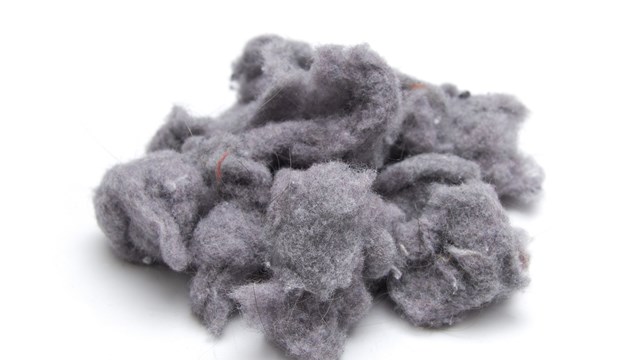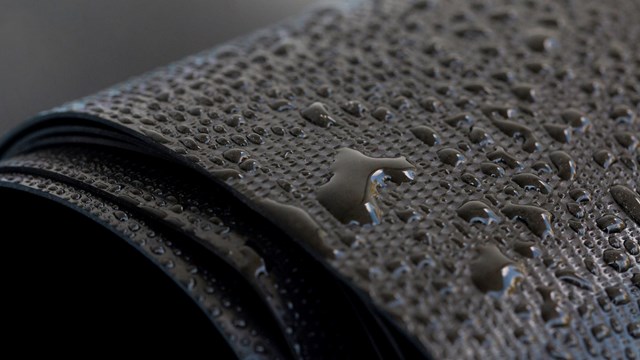When you think of household pests - that's pests, not pets - it's usually bugs and rodents that come to mind. In New York, however, birds are pests too; especially the overabundance of pigeons that congregate on buildings seeking food and shelter and leaving their feathers and droppings behind.
Pigeon messes are not only unsightly, but can also be hazardous to human health. An accumulation of bird waste can wreak havoc in vents, air conditioning units, and even on the delicate façade of a landmarked building. According to Cameron Riddell, president of Bird Barrier America, Inc., a Los Angeles-based bird control company, pest birds cause tens of millions of dollars of damage every year to urban buildings, machinery, automobiles, roofs, ventilation systems and human inhabitants.
Riddell explains that "A well-maintained ventilation system shouldn't even have bird droppings in it, but we do see pigeon problems under ventilation systems, on exposed ledges, in crawl spaces, on signs, and on rooftops."
Aside from being unpleasant to look at, pigeon droppings also contain bacteria. Prolonged exposure to accumulations of bird waste can put residents at risk for life-threatening ailments, including histoplasmosis, a fungal infection that causes potentially fatal swelling around the heart. Other infectious conditions such as salmonella and meningitis can also result, according to Arthur M. Katz, president of Knockout Pest Control located on Long Island.
The New York City Department of Health & Mental Hygiene's Bureau of Communicable Disease reports that in 1999, there were 15 cases reported among New York City residents - translating roughly to a rate of 0.2 cases per 100,000 persons. Not a staggering figure, but one that could probably be reduced to nothing if the problem of congregating birds is properly addressed.
According to the Health Department, histoplasmosis is acquired by inhaling the spore stage of the histoplasmin fungus. Outbreaks may occur in groups with common exposures to bird or bat droppings. In 1997, legendary singer Bob Dylan - who lived in a New York City apartment at the time - was seriously ill and hospitalized with histoplasmosis; although it was not confirmed that exposure to pigeon droppings was the cause of his illness, the city's "winged rats" seem a likely suspect. The Centers for Disease Control (CDC) reports that positive histoplasmin skin tests occur in as many as 80 percent of the people living in areas where the bacteria is common, particularly the eastern and central United States.
Also of special concern to New Yorkers is the fact that pigeons can also carry the infamous West Nile Virus, a mosquito-borne viral infection that can cause inflammation of the brain. West Nile Virus is spread to humans by the bite of infected mosquitoes, but the mosquitoes acquire the virus initially through snacking on the blood of infected birds, more often than not, pigeons.
"There are various methods for the control of pest birds which can be utilized for your unique problem and this includes; exclusionary, baiting, trapping and scaring methods," explains Katz.
For years, New York City building owners and managers have tried all sorts of ways to shoo pigeons. One manager broadcast the shrieking calls of predatory birds from a sound system atop his building. Another more common (and possibly less alarming) technique is installing scarecrows, or even large plastic owls - which are a natural predator to the smaller birds - to scare off those pigeons and starlings. Creative as they are, however, experts agree that these methods are just a temporary fix.
To exclude pest birds such as pigeons, seagulls and sparrows from nesting, netting designed to prohibit these birds from penetrating are placed in areas that need to be protected. This was the case with a recent situation in which Knockout Pest Control was called in to fix at an FAA radio tower. The tower had sparrows nesting inside it, chewing on the wiring and preventing it from working properly. "By netting areas of the tower, the birds could no longer nest in it and cause damage so they simply moved along to another area," says Katz.
"There are more advances in how (realistic) the owls and scarecrows look, including holographic eyes that look like they are following you, but eventually the birds get used to it and come back," says Tim Wong, owner of M&M Pest Control in New York City. Newer owls have also been developed that move, and come equipped with realistic screeching sounds.
Trapping pesky birds may also seem like a good idea, but once the pigeons are released, they'll come right back home to roost. "Pigeons have a gestation period of only 90 days, so at least three families of pigeons can be born each year, says Jim Tuggle, CEO of Avian Flyaway, Inc. in Brooklyn. "And they always want to come back to where they were born." Tuggle has a grudging respect for his adversaries. "Pigeons are very intelligent creatures and have an excellent sense of direction, so [trapping] and artificial owls aren't going to work."
Until just a few years ago, another choice was to simply kill the pigeons or other pesky birds altogether. Avitrol - a toxic pesticide originally used against grain-eating birds in agricultural areas - was mixed in seed that was spread for consumption by the birds. Although the toxin was targeted to pigeons, sparrows, and starlings - the main pest-bird culprits - several red-tailed hawks in Manhattan died as well. The concern of city residents grew when Avitrol was thrown directly on grass where other pets or humans could come in contact with it. As a result, in 2000, Governor George Pataki signed a bill banning the use of Avitrol. Although some bird-plagued cities still consider mass poisoning an option, proponents of such measures face strident opposition from citizens and animal rights activists.
Poison - drastic as it is - may still be just a temporary solution, according to Wong. "You can put as much poison as you want, but you would never really kill off the population," he says. "The best thing to do is exclusion; give the pigeons less of a reason to come into the city. If a developer is designing a building, design it with straight lines - not curves - and [avoid making] areas where birds can hide. Make sure the area is kept clean and has less food."
It might sound hopeless, but there are solutions to combating a bird problem. "The first thing management must do is to eliminate food and water sources," said Riddell, echoing Wong. "Don't feed the pigeons, or they're going to come back."
Various bird removal products are also available and can be installed by building maintenance. Bird control strips are made from stainless-steel wire and act as a physical barrier to prevent pest birds from landing, roosting or nesting on all types of surfaces.
Small metal spikes can be adhered to pigeon-prone areas like ledges, pipes, and chimneys, making them uncomfortable for birdie backsides. "Spikes are an effective way of deterring birds," says Wong. "They can be as low as an inch up to five inches, but [the drawback is] they aren't very attractive."
Environmentally safe, nonpoisonous gel compounds are available that can be applied to ledges, beams, rafters, cornices, and ornamental copings - birds dislike the tacky substance and will avoid landing on the area. "The bird gel is cheap, no more than $75 to $100 to put them around the ledges and window sills," says Wong, but adds that, "The only problem is gels collect dust and turn black because of the pollution, so they will only last six months or so."
No two bird situations are alike so pest control professionals use a host of humane strategies to eliminate the nuisance. For commercial property owners, warehouses, office buildings and apartment buildings there are often unique challenges. At a recent project in New York City, apartment dwellers could no longer open windows; birds had become too comfortable nesting on every window sill. Katz says Knockout used a chemical repellant, which caused the birds to feel discomfort but they were unharmed. The non-toxic repellant, which looks like weather strip caulking, simply makes the bird not want to nest there. Other products such as plastic and metal spikes were also used to prevent them from landing, thus sending them off to find more suitable nesting and roosting areas.
Recently introduced repellants even target the nesting of geese in urbanized commercial areas, according to Katz. The repellant is made from a food extract and is completely safe for people, birds and pets to tread on.
A more lasting solution is to contact professional bird removal companies who are experienced at detecting the nooks and crannies where birds hide and roost, and use techniques to eliminate the birds without doing them great harm, yet still discouraging their return. A professional's first step will be to identify the type of bird that's pestering your building and determine what's attracting it. Step two is to remove that attraction entirely, or to build a barrier between the bird and what it's finding so attractive about your home.
"Make sure you find a professional who is experienced and trained to know what they are looking for," says Riddell. "New York doesn't require bird control companies to have licensing, so be sure to get references and check out the company's background before hiring anyone."
Your building's manager or board should contact the professionals to visually inspect the property initially and decide which remedy is most appropriate for your particular situation. A lot depends on the number and location of the birds. The Department of the Interior, U.S. Fish and Wildlife Service suggests asking the following questions before determining a final removal system:
- Could the recommendation potentially harm people, pets and other wildlife?
- Will the proposed remedy effectively reduce or eliminate the damage done by the birds themselves?
- Is it worth the cost, after initial application and ongoing maintenance?
Your chosen pro might use one, or a combination of, the aforementioned methods of bird repelling, or he or she might apply other means, ranging from the super high-tech - like invisible electric barriers that deliver a mild, non-lethal shock to approaching birds - to the ultra-simple. For example, do pigeons roost in nearby trees? Then trim them (the trees, not the pigeons). Electric barrier systems are a more attractive - though also more expensive - option than spikes or messy gels, and a professional bird control specialist will be able to size up your problem and help you decide on a course of action that fits into your building's budget.
Most pros will help fix any damage already done to your property by feathered fiends, and clean up the evidence they leave behind. "We scrape, double-bag, and dispose of the droppings as hazardous waste, and then we disinfect," says Tuggle. "How long it takes us to install the systems and clean up depends on location and access to the building."
The cost of various products and devices, along with removal of the birds can range from a few hundred dollars for a do-it-yourself job on a small building, up to many thousands of dollars for larger, more complicated problems.
Most birds are welcome tokens of nature in an otherwise harsh urban environment; robins and bluejays are harbingers of spring, and the occasional seagull reminds us of the beach, but hordes of burbling pigeons and squawking starlings molting and defouling property aren't so welcome. If your building is looking more and more like an ad hoc aviary, maybe it's time to take matters into your own hands and reclaim your home from those cheeky-beaked interlopers.







Leave a Comment